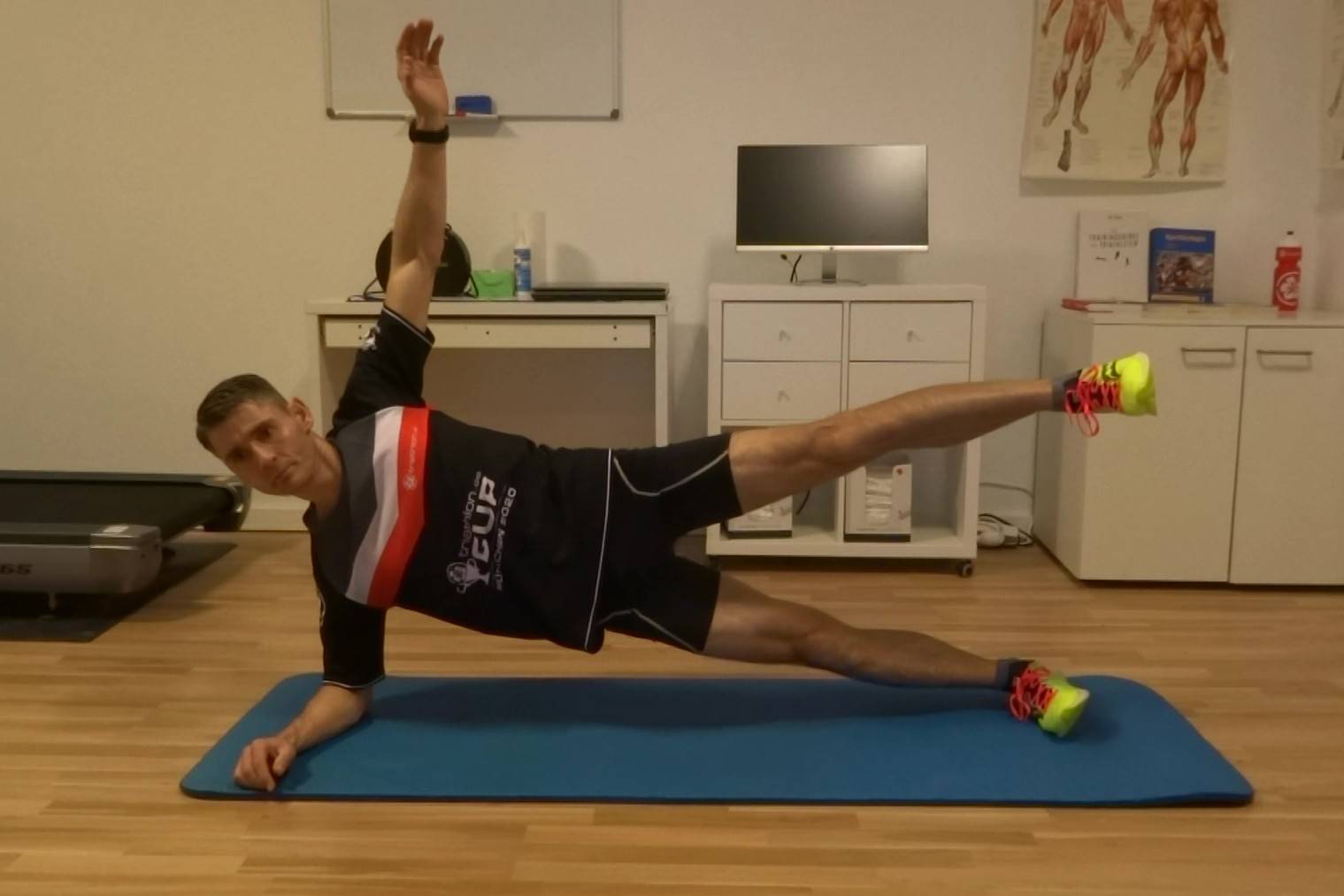Es ist wieder Zeit für Rumpfstabilisationsübungen - kurz "Stabi". Diese unbeliebte Trainingsform wird nur allzu gern vernachlässigt, da sie auf der einen Seite gnadenlos die Schwächen in der Körperstatik aufzeigt. Auf der anderen Seite wird jede Trainingsminute lieber in die Kilometerleistrung beim Schwimmen, Radfahren oder Laufen investiert : "Stabis machen mich schließlich nicht schneller". Weit gefehlt! Du profitierst in jeder Disziplin von einer gut ausgeprägten Rumpfstabilität und bist im Endeffekt signifikant schneller bei gleicher Ausdauerleistung.
- eine gute Grundspannung und stabile Körpermitte verbessert Deine Wasserlage und hilft Dir, deutlich effizienter zu schwimmen
- auf dem Rad entlastest Du Nacken, Schultern, Handgelenke und kannst durch eine verbesserte muskuläre Verkettung größeres Kraftpotenzial auf das Pedal bringen
- beim Laufen hältst Du eine aufrechte Position, knickst weniger in der Hüfte ein und kannst einen effizienteren Laufstil über einen längeren Zeitraum umsetzen.
Unser Trainer Stephan zeigt Dir in unser großen Stabi-Serie die besten Übungen zur Rumpfstabilisierung, die Dich langfristig wirklich voran bringen. Alles, was Du brauchst, ist eine Matte und etwas Platz. Los geht's mit der ersten Übungsreihe.
Unterarmstütz I
Der Klassiker. In der statischen Grundposition vorwärts wird der Körper auf den Unterarmen und den Zehenspitzen abgestützt, der Körper bildet eine gerade Linie. Mit dieser Übung aktivierst Du fast die gesamte Rumpfmuskulatur, Körperspannung pur. Halte diese Übung für mindestens 30 Sekunden.
Unterarmstütz II
Eine Abwandlung der Übung Unterarmstütz mit zusätzlich dynamischer Bewegungsausführung: hebe wechselseitig jeweils ein Bein vom Boden ab, berühre mit der Fußspitze kurz die Ferse des anderen Fußes und setze das Bein dann wieder wieder ab. Achte dabei unbedingt weiterhin auf die Stabilität in Deiner Körpermitte. 6 - 12 Wiederholungen pro Seite.
Unterarmstütz III
Wiederum eine Veränderung der Grundhaltung mit dynamischer Bewegung: drücke Dich aus dem Unterarmstütz wechselseitig in die Liegestützposition heraus und gehe dann wieder zurück in den Unterarmstütz. Auch hier ist wichtig: halte die Spannung bei der Bewegungsausführung aufrecht und den Körper gerade (kein Verwringen, Knicken oder Senken der Hüfte). 5 - 10 Wiederholungen pro Seite.
Käfer
Der Käfer ist eine Übung für die Bauchmuskulatur und ähnelt durch die gegengleiche Arm- und Beinbewegung eben einem Käfer, der auf dem Rücken liegt. Ausgangsposition Rückenlage: linker Arm und rechtes Bein sind lang gestreckt, rechter Arm und linkes Bein sind körpernah angelegt bzw. angewinkelt (siehe Bilderreihe). Bewegungsausführung: Arme und Beine werden nun gleichzeitig in die jeweils entgegen-gesetzte Position bewegt bis zur spiegelverkehrten Ausgangsposition. Du wirst merken, es braucht etwas Übung um Arme und Beine gleichzeitig zu koordinieren. Führe die Bewegung flüssig hintereinander aus, so dass Du immer wieder diagonal arbeitest. 15 - 30 Wiederholungen.
1
2
3
4
Superman
Auch diese Übung verdankt ihren Namen der Körperhaltung. Ausgangsposition Vierfüsslerstand: strecke rechten Arm nach vorn und linkes Bein nach hinten weg - mach Dich so lang wie möglich, baue Spannung über die gesamte Länge auf. Halte die Position für 10 - 15 Sekunden. Anschließend wechsle in eine dynamische Bewegungsausführung: löse die Streckung auf und führe Knie und Ellbogen unter dem Körper zusammen, gehe anschließend wieder in die komplette Streckung. Achte auf einen stabilen Halt und führe die Bewegung flüssig hintereinander 10 - 15 Mal. Anschließend Seitenwechsel.
Beinheben
Bleibe für diese Übung im Vierfüsslerstand. Für die Ausgangsposition: hebe ein Bein an, Oberschenkel waagrecht, Unterschenkel senkrecht nach oben. Bewegungsausführung: "stoße" den Unterschenkel nun geradlinig nach oben in Richtung Decke. Lass die Fußsohle dabei immer waagerecht initiiere die Bewegung aus dem unteren Rücken bzw. Gesäßmuskel heraus. Senke das Bein ab und wiederhole die Stoßbewegung 8 - 12 Mal. Anschließend Seitenwechsel.
Armkreisen in Bauchlage
Mit dieser Übung bringst Du Spannung in Deine gesamte Rückenmuskulatur und nutzt den gesamten Bewegungsspielraum Deines Schultergelenks aus. Ausgansposition Bauchlage: Arme sind lang nach vorn gestreckt, die Handflächen schweben wenige Zentimeter über dem Boden. Streck Dich so lang wie möglich und halte diese Grundposition für ein paar Sekunden. Beginne anschließend mit großen Armkreisen, indem Du die gestreckten Arme in großem Bogen hinter den Körper führst (die Hände können sich über dem Po berühren). Schwenke die gestreckten Arme wieder zurück in die Ausgangsposition. 8 - 12 Wiederholungen.
Kraulschwimmen
Bleibe in Bauchlage. Bei dieser Übung werden die Arme wechselseitig eng am Körper geführt. Ausgangsposition: ein Arm liegt lang gestreckt von, der andere Arm gestreckt am Körper. Nun werden beide Arme gleichzeitig entgegengesetzt - ähnlich dem Kraularmzug - bewegt. Ganz wichtig: 1. enge Armführung am Körper und 2. stabiler Oberkörper, keine Schlängelbewegung. An dieser Übung kannst Du sehr gut erkennen, wie negativ sich eine eingeschränkte Schulterbeweglichkeit auf die Stabilität der Wasserlage auswirken kann. Übungsvorschlag: 15 - 20 Armzüge pro Seite.
Seitstütz I
Diese Übung ist Stabi für Fortgeschrittene. Der seitliche Unterarmstütz spricht vor allem die seitliche Rumpfmuskulatur an und ist anspruchsvoller als die vorwärts gerichtete Stützvariante. Ausgangsposition: Stütze Dich in Seitlage auf den Unterarm und die äußere Fußkante. Drücke die Hüfte nach oben, dass der Körper geradlinig ausgerichtet ist. Strecke den entlasteten Arm nach oben und halte diese Position für 10 - 20 Sekunden. Achte ebenfalls darauf, dass Du mit der Hüfte ebenso wenig nach hinten abkippst und auch in dieser Achse geradlinig bleibst.
Seitstütz II
Stabi Expertenmodus! Auch hier kannst Du den Schwierigkeitsgrad noch einmal erhöhen, indem Du aus der Grundposition heraus das obere Bein nach oben abspreizt und Du damit die Abduktoren richtig forderst. Diese Übung kannst Du statisch (Bein oben halten) oder dynamisch (heben, senken) durchführen.
Viel Spaß beim Training!
Hier findest Du weitere Übungsreihen:





















1 Kommentar
Andy
Hey zusammen.
Klasse Serie die ihr da bringt.
Da ich im Winter etwas in meine Rumpf Stabi investieren möchte:
Was ist Eure Empfehlung? Wie viele Übungen der 3 Serien sollte man pro Woche einbauen? Und würdet ihr eher z.B. 12 Unterschiedliche Übungen machen, oder 4 Übungen á 3 Sätze?
Beste Grüße,
Andreas